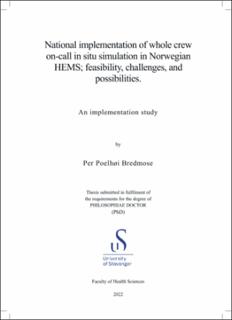| dc.contributor.author | Bredmose, Per Poelhøi | |
| dc.date.accessioned | 2022-10-25T11:44:56Z | |
| dc.date.available | 2022-10-25T11:44:56Z | |
| dc.date.issued | 2022-10 | |
| dc.identifier.citation | National implementation of whole crew on-call in situ simulation in Norwegian HEMS; feasibility, challenges, and possibilities : An implementation study by Per Poelhøi Bredmose, Stavanger : University of Stavanger, 2022 (PhD thesis UiS, no. 667) | en_US |
| dc.identifier.isbn | 978-82-8439-124-3 | |
| dc.identifier.issn | 1890-1387 | |
| dc.identifier.uri | https://hdl.handle.net/11250/3028183 | |
| dc.description.abstract | This research project is a PhD-project on implementing medical orientated in situ simulation for on-call air ambulance crews in Norway, and the alternative use of “observed clinical practise” in real-life missions when simulations cannot be carried out. Since HEMS duty is typically a standby emergency service, there are periods between missions where training can be carried out. However, these free periods are unpredictable, and the planning of training can be challenging. Thus, we initially want to test in situ simulation training feasibility on HEMS bases in Norway.
This thesis consists of four different studies using several research methods. The first study is a prospective quantitative interventional study, where one facilitator introduces in situ simulation training on one HEMS base in Norway to evaluate the feasibility of such training. In Study II, the same training concept was sought introduced on all HEMS bases in Norway and one SAR base. Both Studies I and II evaluate the participants' experience with a Likert-style questionnaire as well as using descriptive data. In relation to introducing in situ simulation nationally, the expected barriers to the introduction were studied with a qualitative method. Facilitators from the participating bases underwent structured group interviews in Study III. After the one-year study period, the facilitators were interviewed about the experienced barriers and the tools used to overcome these. Finally, in Study IV, a solution was sought to use facilitators more efficiently by combining in situ training with live mission observations. Study IV combines descriptive data, questionnaires, and phone-based individual interviews.
We have found that in situ simulation training for on-call crews is feasible and can be implemented with a high level of satisfaction from participating crews.
There were some challenges to the implementation that the facilitators have tried to overcome. A more rigid framework and follow up might have improved the implementation. It seemed difficult to conduct simulations successfully on the busier bases. Some of the key factors for
the implementation was found to be the use of a facilitator with local knowledge, support from the departmental managers, dedicated time for the facilitators to prepare and lead the training, and the need for continuous development within the role as facilitator. We suggest live mission observation with post-mission debriefing as a feasible alternative to in situ simulation to maximise invested resources and maintain the learning output. | en_US |
| dc.language.iso | eng | en_US |
| dc.publisher | University of Stavanger, Norway | en_US |
| dc.relation.ispartofseries | PhD thesis UiS; | |
| dc.relation.ispartofseries | ;667 | |
| dc.relation.haspart | Paper 1: Bredmose PP, Hagemo J, Røislien J, Østergaard D, Sollid S. In situ simulation training in helicopter emergency medical services: feasible for on-call crews? Advances in Simulation. 2020;5(1):1-7. | en_US |
| dc.relation.haspart | Paper 2: Bredmose PP, Røislien J, Østergaard D, Sollid S. National Implementation of in situ simulation-based training in helicopter emergency medical services: a multicenter study. Air Med J. 2021;40(4):205-10. | en_US |
| dc.relation.haspart | Paper 3: Bredmose PP, Østergaard D, Sollid S. Challenges to the implementation of in situ simulation at HEMS bases: a qualitative study of facilitators’ expectations and strategies. Advances in Simulation. 2021;6(1):1-11. | en_US |
| dc.relation.haspart | Paper 4: Bredmose PP, Hagemo J, Østergaard D, Sollid S. Combining in-situ simulation and live HEMS mission facilitator observation: a flexible learning concept. BMC Med Educ. 2021;21(1):1-10. | en_US |
| dc.rights | Copyright the author | |
| dc.rights | Navngivelse 4.0 Internasjonal | * |
| dc.rights.uri | http://creativecommons.org/licenses/by/4.0/deed.no | * |
| dc.subject | akuttmedisin | en_US |
| dc.subject | luftambulanse | en_US |
| dc.subject | HEMS | en_US |
| dc.title | National implementation of whole crew on-call in situ simulation in Norwegian HEMS; feasibility, challenges, and possibilities : An implementation study | en_US |
| dc.type | Doctoral thesis | en_US |
| dc.rights.holder | ©2022 Per Poelhøi Bredmose | en_US |
| dc.subject.nsi | VDP::Medisinske Fag: 700 | en_US |

